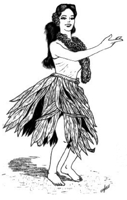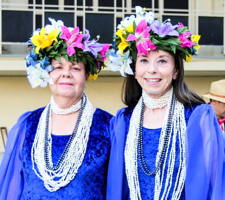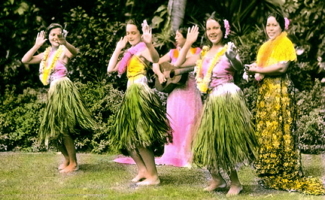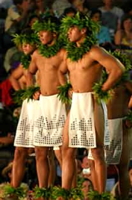
|
The Society of Folk Dance Historians (SFDH)
Hula
[
Home |
About |
Encyclopedia | CLICK AN IMAGE TO ENLARGE |
BACKGROUND
Information: The Hula is a proud dance of Hawaiʻi using the hands to tell the story, the hips and feet to keep the rhythm, and the face to convey mood and emotion.
TYPES OF HULA
There are two types or styles of Hula in existence today:
Hula Auana or Hula Auwana (ow-AH-nah) – meaning to "wander" or "drift" – the modern, familiar, and graceful dance of Hawaiʻi today – uses both native implements and European musical instruments, such as, the ukulele, guitar, and steel guitar. Words are both English and Hawaiʻian or a combination of the two.
Ai Kahiko (aee kah-HEE-ko) – meaning "in the ancient style" – is a dance form accompanied by chant (oli) or song (mele) and has enjoyed a great rebirth. It is a faster, more vigorous style of hula in which the dancers are accompanied by a strong, percussive beat and chanting. Its origins are basically "pre-missionary" and it uses only native implements and the Hawaiʻian language, with minimal European influence on the music or steps.
Men have always danced the Hula and were among the first Kumu Hula ("hula masters"). Male dancers were trained with the female, although there are many Hulas that are suitable in style and content for men specifically. Foot patterns are the same for both men and women, though men's hand motions do not have the soft and graceful undulation that women and girls use.
- Ami Kāhela
- Rotation of the hips, one rotation per beat.
- Ami Kūkū
- Same as the Ami Kāhela, except that the revolutions are small, faster, and in groups of three.
- Hela
- One ft is placed at about a 45-degree angle to the front, with the wt on the opp hip and with that knee bent. The ft is then returned to the original position and the step is repeated with the other ft.
- Kaʻo
- Side-to-side hip sway. Feet: Step R, touch L, and reverse.
- Kāholo
- Extend one ft to the side. Bring the other along side. (Step, together, step, touch.) Repeat with the other ft.
- Kāholo Huli
- To execute the Kāholo while turning in a circle – if initiating the Kāholo with the R ft, the turn will be toward the R.
-
 Kāholo Swing
Kāholo Swing
- To execute the Kāholo wo the R or L with 1/4 or 1/2 turn.
- Kawelu
- Step fwd with one ft while the other is stationary, lifting the stationary ft off the heel slightly, shifting the wt (hips) accordingly. Can be done traveling.
- Lele
- Step fwd on R ft (ct 1); tap ball of L ft next to R ft (ct 2); step fwd on L (ct 3); tap ball of R ft next to L ft (ct 4). Variations: Step Tap bkwd or walk "around the island." Can also be done with no tap.
- Olapa
- With wt on L, R ft moves to the side (ct 1); R ft moves to the front (ct 2); R ft moves together next to L (ct 3); Ūwehe (ct 4). Step is then repeated using the L ft. Occasionally, the entire step is done in reverse by moving the ft to the front first, then side, together, and Ūwehe.
- Ūwehe
- One ft is lifted with wt shifting to the opp hip as the ft is lowered. Both knees are then pushed fwd by the quick raising of the heels with continued swaying of the hips from side to side.
- Ūwehe
- One ft is lifted with wt shifting to the opp hip as the ft is lowered. Both knees are then pushed fwd by the quick raising of the heels with continued swaying of the hips from side to side.
The following information on hula implements is provided for the teacher's general knowledge. As most of these implements are not readily available on the mainland, we will not go into great detail on their usage at this time. Perhaps that would be a good subject for later, more advance hula material and videotape.
- ʻIliʻili
- (EE-lee-EE-lee) Four smooth, oval stones, often of volcanic rock, that are held two in each hand. When clicked together, they sound similar to the noise made by Spanish castanets.
- ʻUlīʻulī
- (oo-LEE-oo-LEE) A small gourd or coconut partially filled with canna seeds that make a "rattle" sound when shaken. It is held by a handle and covered with a feathered, circular top, usually of red and yellow or natural brown feathers.
- Ipu
- (EE-poo) A large, hollow gourd held by the neck in the left hand and hit with the heel and fingers of the right hand to produce a resonant, drum-like sound.
- Ipu heke
- (EE-poo HEH-keh) A double Ipu is created by gluing two smaller Ipus together. It is used in ancient hula and is played by the chanter, who sits and strikes it with the hand and on the ground.
- Kālaʻau
- (kah-lah-OW) Sticks made of Hiʻa or Kauila wood about twelve inches long that are struck together to produce a sharp, staccato sound.
- Pahu.
- (PAH-hoo) A sharkskin-covered drum, considered sacred.
- Pūʻili
- (poo-EE-lee) Two sections of bamboo stalks that have been split into narrow strips. When struck on the body or against each other, they produce a pleasant, rustling sound.
- Puniu.
- (poo-NEE-oo) A small knee drum made of coconut shell with fish skin ("kala") cover.
- Ipu Heke
- (EE-poo HEH-keh) A double ipu is created by gluing two smaller ipus together. It is used in ancient hula na is played by the chanter, who sits and strikes it with the hand an on the ground.
- Tiger Coweries
- Shells.
DOCUMENTS
- Hawaiʻi, a region.
- Merlyn Gentry and Nora Nuckles, an article.
- Polynesia, a region.
Used with permission of the authors.
Reprinted from the 2000, 2005, and 2008 Stockton Folk Dance Camp syllabi.
This page © 2018 by Ron Houston.
Please do not copy any part of this page without including this copyright notice.
Please do not copy small portions out of context.
Please do not copy large portions without permission from Ron Houston.




